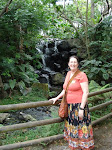After everyone was situated in their rooms, the group did some observing for the lab project. While most of the guys and I set up the tents for tomorrow's experiments, the rest of the group observed the behaviors of the hummingbirds and recorded their feeding habits. After each group had taken their shifts observing, we had all become experts at identifying the different appearances and behaviors of the 4 types of hummingbirds.
Fiery Throated - Small yet aggressive, these punks would chase any other hummingbirds away from their feeders. They could be identified by a "fiery" red pattern of feathers on on their breast.
Green Velvet-eared - Long curved beaks and velvet ears; easily intimidated by the fiery throated
Magnificent - The largest of them all
Volcano - The rarest and smallest, only a few were spotted and only one was caught the entire trip
The next day we set up nets to catch hummingbirds and observe them up close. After hummingbirds were caught we got the chance to hold them and take a sample of pollen on their beak, in order to see if the feeders were affecting their feeding habits on pollinating flowers.
*No hummingbirds were harmed in this process*

After we were able to take the samples, we took a closer look through the microscopes. We counted pollen found and recorded the results for when we returned to the classroom.


Before we were completely done we took a trip to a dwarf forest. We hiked a short distance to the peak of a mountain, in the highest altitude many of us had ever been. On the top of the mountain there was an extreme lack of animal life, and all bushes and trees were no more than waist height; making the name dwarf forest very fitting. The views through the clouds were amazing, and after some exploring of the peak we got together to talk about the differences here from all other forests. Before climbing down the group took advantage of the situation and sat in silence while centering thought.

All in all the weekend included great opportunities to learn, as well as new experiences for everyone.

























No comments:
Post a Comment